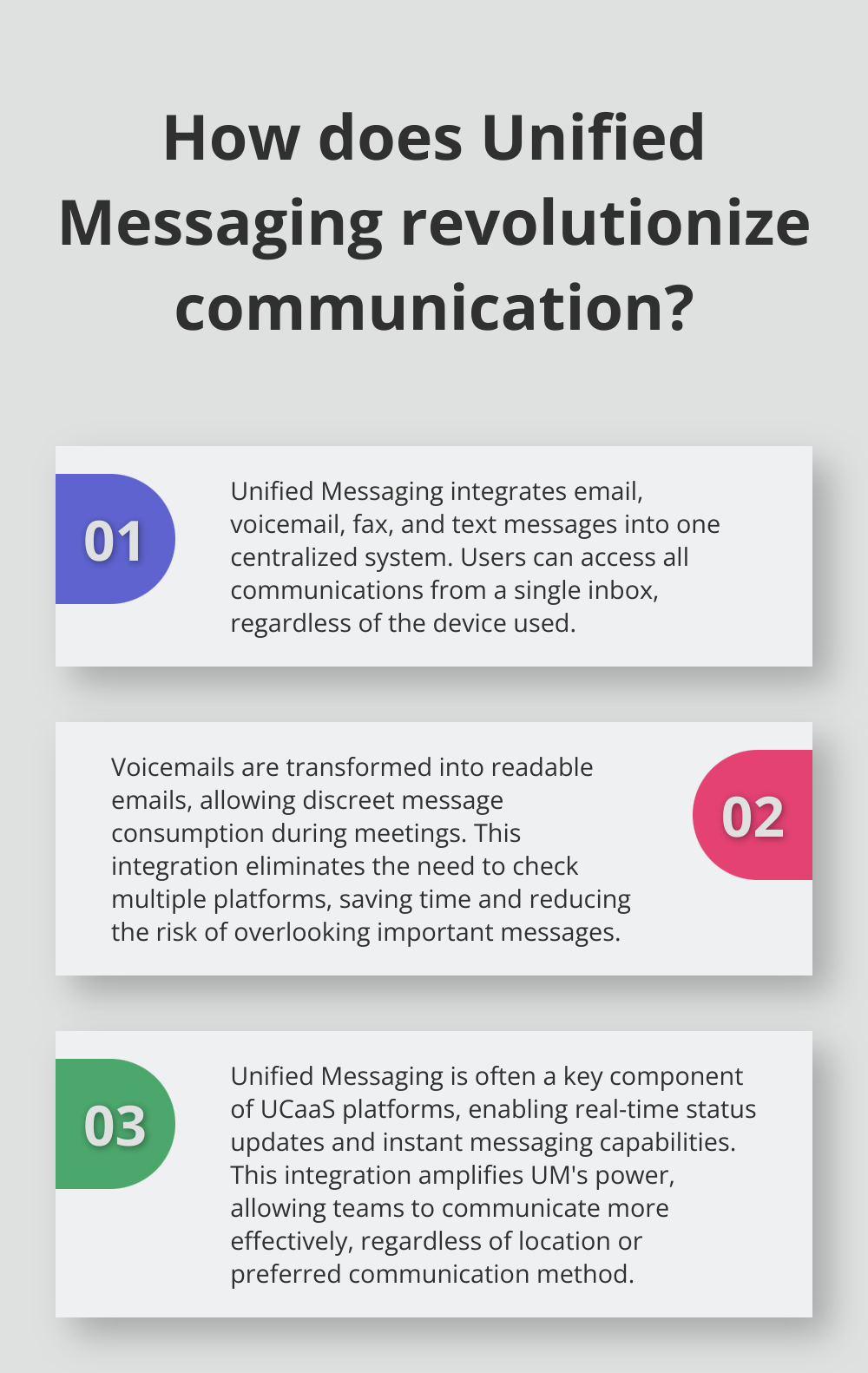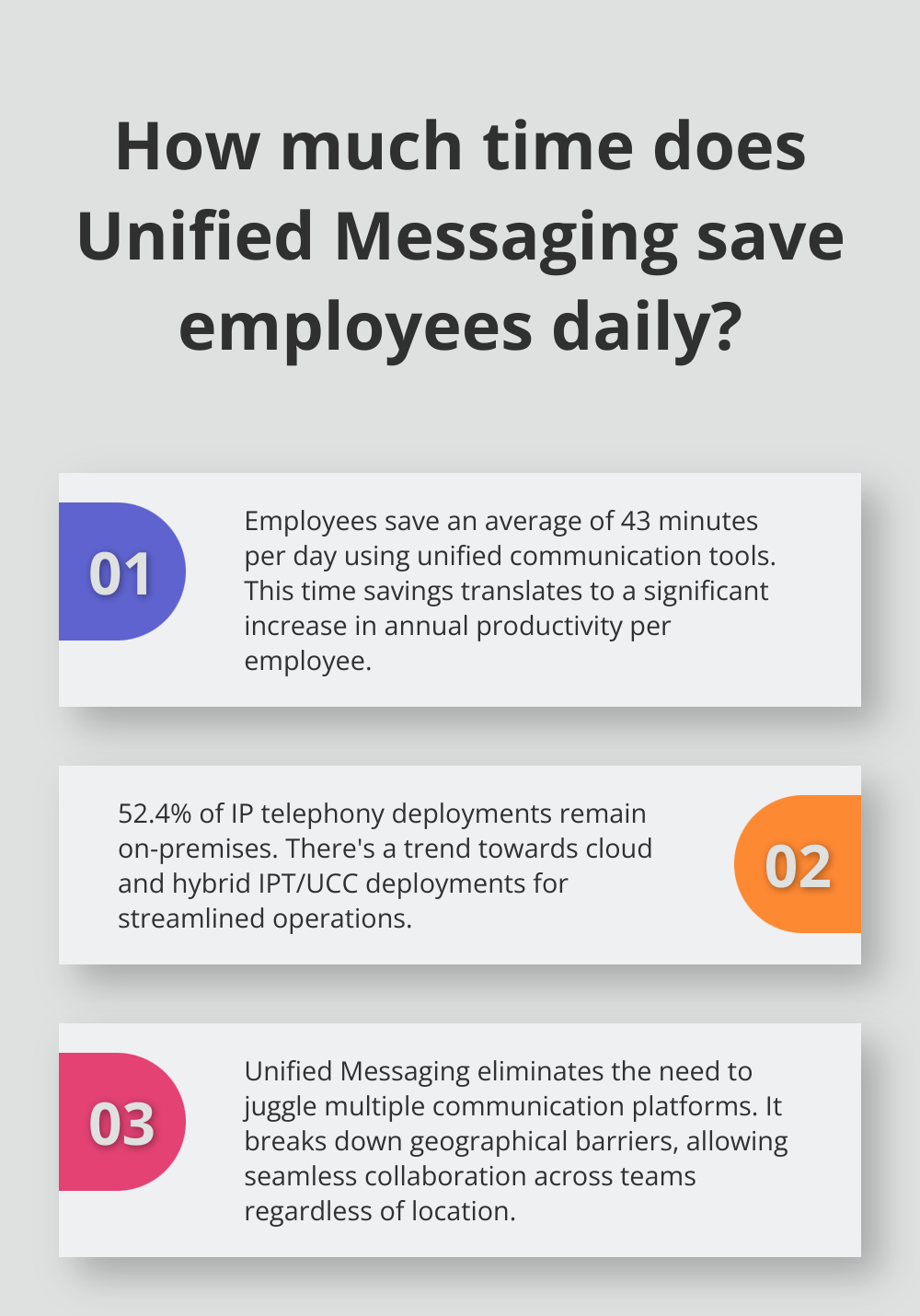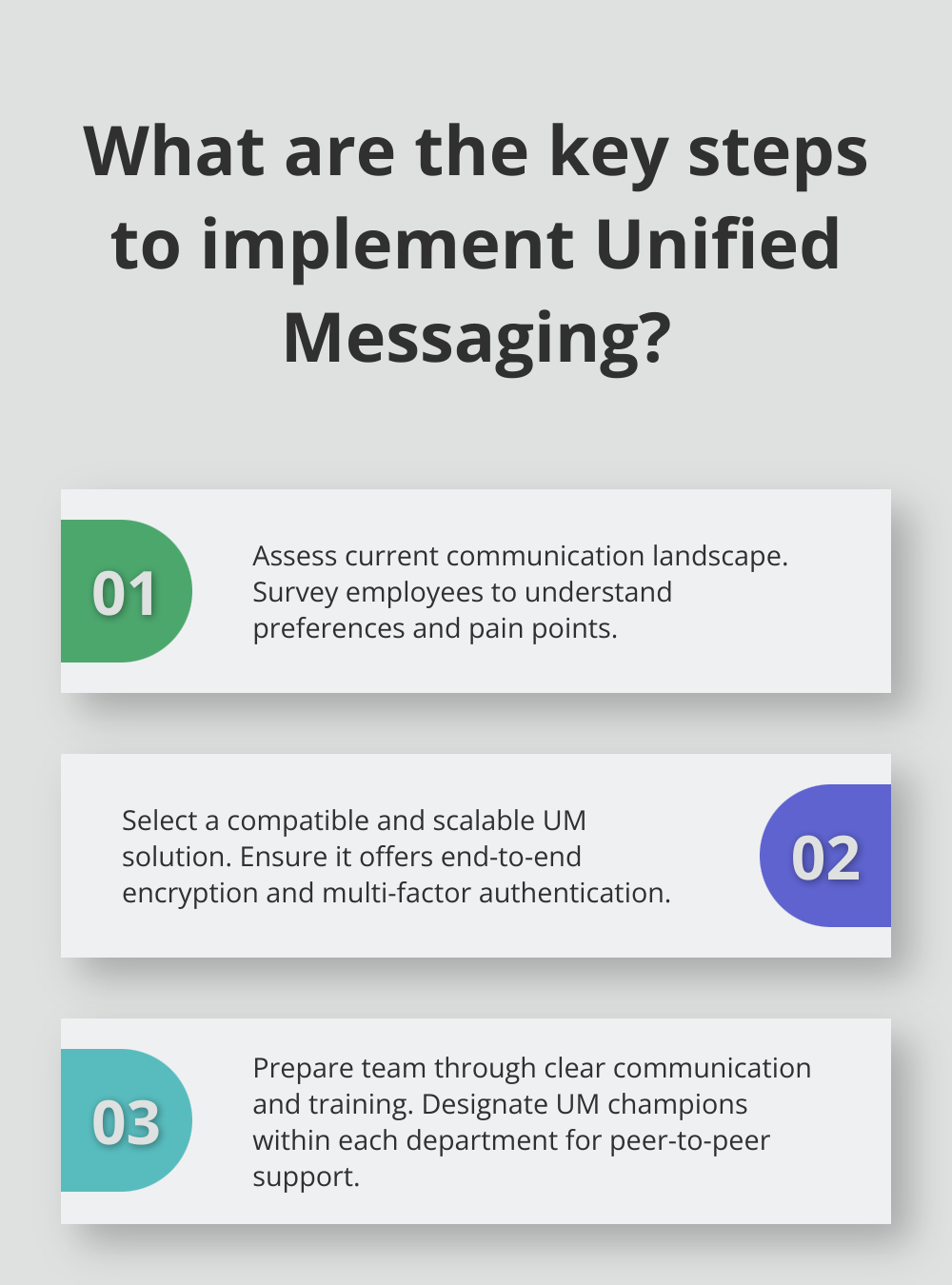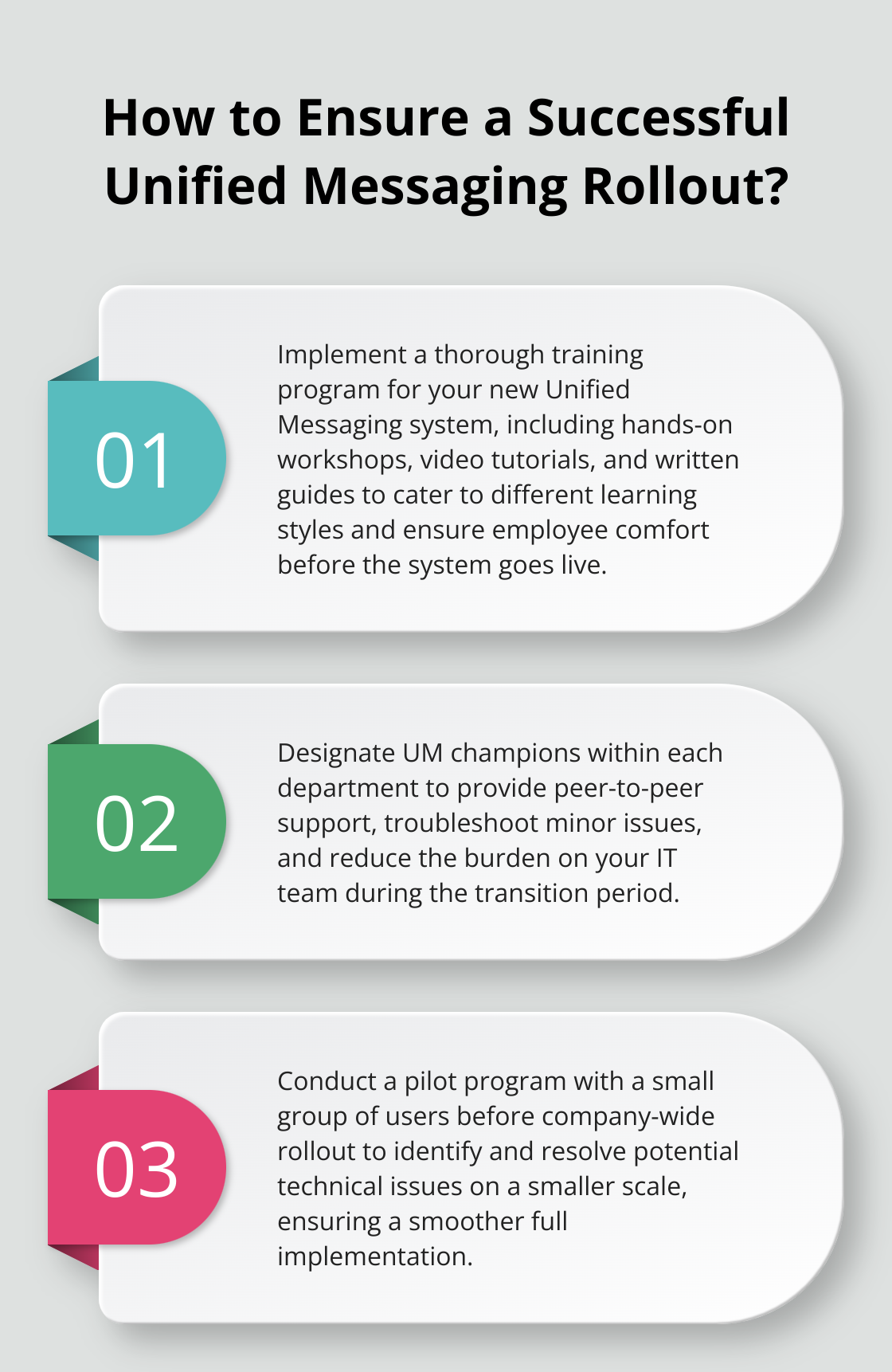Effective communication is key to business success. Unified messaging has emerged as a game-changing solution, revolutionizing how companies handle their internal and external communications.
At UCaaS Review, we’ve seen firsthand how unified messaging can transform businesses, boosting productivity and streamlining operations. This blog post will explore why unified messaging is a must-have for modern enterprises and how it can give your company a competitive edge.
What Is Unified Messaging?
The Essence of Unified Messaging
Unified Messaging (UM) combines various messaging formats into a single, accessible interface. It’s the digital equivalent of a universal mailbox for all your communications.
Core Components
UM integrates email, voicemail, fax, and text messages into one centralized system. Users access all communications from a single inbox, regardless of the device (computer, smartphone, or tablet). For instance, voicemails transform into readable emails, allowing discreet message consumption during meetings.
A Departure from Traditional Systems
UM breaks away from traditional messaging systems that segregate communication channels. This integration eliminates the need to check multiple platforms, saving time and reducing the risk of overlooking important messages.
UCaaS Integration
Unified Messaging often serves as a key component of Unified Communications as a Service (UCaaS) platforms. This integration amplifies UM’s power, enabling real-time status updates, presence information, and instant messaging capabilities. Teams communicate more effectively, regardless of location or preferred communication method.

Consider this scenario: A sales representative receives a client voicemail, which UM transcribes and sends to their email. The rep then shares it instantly with their team via a UCaaS platform’s chat function-all without switching applications.
Enhanced Communication Ecosystem
The power of unified messaging within a UCaaS framework creates a more cohesive and efficient communication ecosystem. This improvement extends beyond internal collaboration to customer interactions, ensuring no message slips through the cracks.
As businesses continue to evolve their communication strategies, the role of Unified Messaging becomes increasingly significant. The next section will explore the tangible benefits that UM brings to businesses, from increased productivity to improved customer satisfaction.
How Unified Messaging Transforms Business Operations
Supercharging Productivity
Unified Messaging (UM) eliminates the need to juggle multiple communication platforms. Employees save an average of 43 minutes a day when using unified communication tools, according to a Sage Research user study. This time savings equates to a significant increase in productivity per employee annually.
Seamless Collaboration Across Teams
UM breaks down geographical barriers. Teams collaborate effortlessly, regardless of their location or preferred communication method. A project manager in New York can leave a voicemail for a team member in London, who receives it as a text message and responds via email – all within the same system. This seamless interaction creates a more cohesive work environment and accelerates decision-making processes.
Slashing Costs, Boosting Efficiency
UM significantly reduces communication-related expenses. Companies consolidate multiple systems into one, cutting down on hardware costs, maintenance fees, and IT support. Research indicates that 52.4% of IP telephony deployments remain on-premises, but there’s a movement toward cloud and hybrid IPT/UCC deployments. The streamlined operations lead to fewer missed messages and faster response times, directly impacting the bottom line.
Elevating Customer Experience
UM’s impact on customer service stands out as one of its most compelling benefits. Customer service representatives provide faster, more accurate responses with all communication channels integrated. They access a customer’s entire communication history instantly, regardless of the channel used. This comprehensive view allows for more personalized and efficient service.
Future-Proofing Communication Infrastructure
As businesses adapt to evolving work environments and customer expectations, UM plays a pivotal role in future-proofing communication infrastructure. It provides the flexibility to integrate new technologies (such as AI-powered chatbots) and communication channels as they emerge, ensuring that businesses stay ahead of the curve.

The transformative power of Unified Messaging extends beyond mere convenience. It serves as a strategic tool that enhances operational efficiency and customer relationships. The next section will explore the practical steps businesses can take to implement UM effectively and maximize its benefits.
How to Implement Unified Messaging Successfully
Assess Your Current Communication Landscape
Start with a thorough evaluation of your existing communication infrastructure. Identify the tools and platforms your team uses for email, voicemail, instant messaging, and other forms of communication. Take stock of any legacy systems that you might need to phase out or integrate.

Survey your employees to understand their communication preferences and pain points. This insight will help you choose a UM solution that addresses real needs and encourages adoption. For example, if many employees struggle with managing voicemails, prioritize a solution with robust voicemail-to-text capabilities.
Select the Right Unified Messaging Solution
When you choose a UM solution, make compatibility with your existing systems a top priority. Look for providers that offer seamless communication and collaboration. Consider scalability as another key factor. Your chosen solution should grow with your business. Cloud-based options often provide the flexibility to add or remove users easily, making them ideal for companies with fluctuating workforce sizes.
Security features are non-negotiable. Ensure the UM solution you select offers end-to-end encryption, multi-factor authentication, and compliance with relevant industry standards (like HIPAA or GDPR).
Prepare Your Team for the Transition
Employee buy-in is critical for successful UM implementation. Start by clearly communicating the benefits of the new system to your team. Highlight how it will enhance their internal communication and improve overall productivity.
Develop a comprehensive training program that caters to different learning styles. This might include hands-on workshops, video tutorials, and written guides. The goal is to make employees comfortable with the new system before it goes live.
Designate UM champions within each department. These individuals can play a critical role in reducing implementation barriers and provide peer-to-peer support, helping troubleshoot minor issues and reducing the burden on your IT team during the transition period.
Navigate Common Implementation Hurdles
One frequent challenge is resistance to change. Combat this by involving key stakeholders in the decision-making process and addressing concerns proactively. Share success stories from other companies that have implemented UM to build confidence in the transition.
Technical issues during implementation can derail the process. Mitigate this risk by conducting a pilot program with a small group of users before you roll out the system company-wide. This allows you to identify and resolve potential problems on a smaller scale.
Data migration often becomes a stumbling block. Work closely with your chosen provider to develop a robust migration plan. This should include strategies for transferring historical data and ensuring continuity of service during the switchover.
Implementing Unified Messaging is a significant undertaking, but the benefits far outweigh the challenges. Follow these practical steps and leverage expert guidance to transform your business communication infrastructure and set the stage for improved productivity and collaboration.
Final Thoughts
Unified messaging has revolutionized modern business communication. It integrates various channels into a single, accessible platform, which boosts productivity and enhances customer satisfaction. The ability to access all messages from one interface saves time and ensures no critical information is overlooked.

The future of unified messaging will incorporate advanced technologies like artificial intelligence and machine learning. These innovations will automate message processing, improve voice-to-text accuracy, and provide intelligent routing of communications. The integration of unified messaging with other business tools will create a more seamless work environment.
Businesses seeking to implement or upgrade their unified messaging systems must find the right solution. UCaaS Review uses AI technology to match businesses with the best Unified Communications as a Service providers in just three minutes. We provide personalized recommendations based on specific communication needs and leverage a vast pool of verified user reviews.



